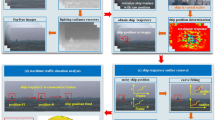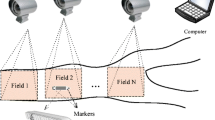Abstract
Ship trajectory in maritime surveillance videos provides crucial on-site traffic information (e.g., ship speed, traffic volume, density) to help maritime traffic situation awareness and management in the smart ship era. To that aim, many focuses are paid to track ships from maritime videos by exploring distinct visual features from maritime images, which may fail under complex maritime environment interference (occlusion, sea clutter interference, etc.). The study proposes a novel video-based ship tracking framework with the help of Multi-view learning model and data quality control procedure. First, we obtain raw ship positions from maritime images with particle filter and Multi-view learning models. Then, a data quality control procedure is implemented to suppress ship tracking outliers with the help of Kalman filter. Finally, we verify our proposed model performance on three typical maritime traffic situations (ship occlusion, sea clutter interference and small ship tracking).





Similar content being viewed by others
Data availability
All data used for this study can be obtained from the corresponding author by sending a request email.
References
Cao X et al (2019) Ship recognition method combined with image segmentation and deep learning feature extraction in video surveillance. Multimed Tools Appl 79(13–14):9177–9192
Chen X et al (2018) Robust ship tracking via multi-view learning and sparse representation. J Navig 72(1):176–192
Chen X et al (2020) Ship type recognition via a coarse-to-fine cascaded convolution neural network. J Navig 73(4):813–832
Chen X, Wu S, Shi C, Huang Y, Yang Y, Ke R, Zhao J (2020) Sensing data supported traffic flow prediction via denoising schemes and ANN: a comparison. IEEE Sensors J 20(23):14317–14328
Chen X et al (2021) Traffic flow prediction by an ensemble framework with data denoising and deep learning model. Physica A 565:125574
Comaniciu D, Ramesh V, Meer P (2000)Real-time tracking of non-rigid objects using mean shift. In Proceedings IEEE Conference on Computer Vision and Pattern Recognition. CVPR 2000 (Cat. No.PR00662)
Hu H-M, Guo Q, Zheng J, Wang H, Li B (2019) Single image defogging based on illumination decomposition for visual maritime surveillance. IEEE Trans Image Process 28(6):2882–2897
Huang Y et al (2020)GPU-accelerated compression and visualization of large-scale vessel trajectories in maritime IoT industries. IEEE Internet Things J 7(11):10794–10812
Jiang M, Zhao Y, Kong J (2020) Mutual learning and feature fusion siamese networks for visual object tracking. IEEE Trans Circuits Syst Video Technol 31(8):3154–3167
Kang X, Song B, Guo J, Du X, Guizani M (2019) A self-selective correlation ship tracking method for Smart Ocean systems. Sensors 19(4):1–21
Lang H, Wu S, Xu Y (2018) Ship classification in SAR images improved by AIS knowledge transfer. IEEE Geosci Remote Sens Lett 15(3):439–443
Liu Y et al (2019) Intelligent tracking of moving ships in constrained maritime environments using AIS. 50(6):539-555
Liu Y et al (2019)GF-4 satellite and automatic identification system data fusion for ship tracking. IEEE Geosci Remote Sens Lett 16(2):281–285
Liu RW et al (2021) An enhanced CNN-enabled learning method for promoting ship detection in maritime surveillance system. Ocean Eng 235:109435
Maresca S et al (2014) Maritime surveillance using multiple high-frequency surface-wave radars. IEEE Trans Geosci Remote Sens 52(8):5056–5071
Mei X et al (2015) Robust multitask multiview tracking in videos. IEEE Trans Neural Netw Learn Syst 26(11):2874–2890
Mittal M et al (2019) An efficient edge detection approach to provide better edge connectivity for image analysis. IEEE Access 7:33240–33255
Pallotta G, Vespe M, Bryan K (2013) Vessel pattern knowledge discovery from AIS data: a framework for anomaly detection and route prediction. Entropy 15(12):2218–2245
Park S et al (2017) Compact HF surface wave radar data generating simulator for ship detection and tracking. IEEE Geosci Remote Sens Lett 14(6):969–973
Shao Z et al (2020)Saliency-aware convolution neural network for ship detection in surveillance video. IEEE Trans Circuits Syst Video Technol 30(3):781–794
Shu Y et al (2018) Calibration and validation for the vessel maneuvering prediction (VMP) model using AIS data of vessel encounters. Ocean Eng 169:529–538
Silvas E et al (2016) Synthesis of realistic driving cycles with high accuracy and computational speed, including slope information. IEEE Trans Veh Technol 65(6):4118–4128
Sun Z, Bebis G, Miller R (2005)On-road vehicle detection using evolutionary Gabor filter optimization. IEEE Trans Intell Transp Syst 6(2):125–137
Tu E et al (2018) Exploiting AIS data for intelligent maritime navigation: a comprehensive survey from data to methodology. IEEE Trans Intell Transp Syst 19(5):1559–1582
Vivone G, Braca P, Horstmann J (2015)Knowledge-based multitarget ship tracking for HF surface wave radar systems. IEEE Trans Geosci Remote Sens 53(7):3931–3949
Wu B et al (2020) A quantitative decision-making model for emergency response to oil spill from ships. Marit Policy Manag 48(3):299–315
Wu B et al (2021) Bayesian Network modelling for safety management of electric vehicles transported in RoPax ships. Reliab Eng Syst Saf 209:107466
Xiu S, Wen Y, Yuan H, Xiao C, Zhan W, Zou X, Zhou C, Shah SC (2019) A multi-feature and multi-level matching algorithm using aerial image and AIS for vessel identification. Sensors 19(6):1–19
Yang M, Wu Y, Hua G (2009)Context-aware visual tracking. IEEE Trans Pattern Anal Mach Intell 31(7):1195–1209
Yu Y et al (2021) Evaluation model and management strategy for reducing pollution caused by ship collision in coastal waters. Ocean & Coastal Management 203:105446
Zechuang C et al (2017) (Automatic detection and tracking of ship based on mean shift in corrected video sequences. In 2017 2nd International Conference on Image, Vision and Computing (ICIVC)
Zhang W et al (2020)Multi-ship following operation in ice-covered waters with consideration of inter-ship communication. Ocean Eng 210:107545
Zhang W, Zhang P, Yu Y, Li X, Biancardo SA, Zhang J (2021) Missing data repairs for traffic flow with self-attention generative adversarial imputation net. IEEE Transactions on Intelligent Transportation Systems, Early Access, pp 1–12
Zhang Sr Y et al (2020) A ship target tracking algorithm based on deep learning and multiple features. In Twelfth International Conference on Machine Vision (ICMV 2019). International Society for Optics and Photonics
Zhou Y et al (2019) Multiple Kernelized Correlation Filters (MKCF) for Extended Object Tracking Using X-Band Marine Radar Data. IEEE Trans Signal Process 67(14):3676–3688
Acknowledgements
This work was jointly supported by the National Key R&D Program of China (2019YFB1600602), National Natural Science Foundation of China (52102397, 52071200, 51978069, 52072237, 62073212, 71942003), Shanghai Planning Office of Philosophy and Social Science (2019EGL018), Shanghai Committee of Science and Technology, China (18DZ1206300), China Postdoctoral Science Foundation (2021M700790).
Author information
Authors and Affiliations
Contributions
All the authors equally contributed for the study.
Corresponding author
Additional information
Publisher’s note
Springer Nature remains neutral with regard to jurisdictional claims in published maps and institutional affiliations.
Rights and permissions
About this article
Cite this article
Chen, X., Chen, H., Xu, X. et al. Ship tracking for maritime traffic management via a data quality control supported framework. Multimed Tools Appl 81, 7239–7252 (2022). https://doi.org/10.1007/s11042-022-11951-y
Received:
Revised:
Accepted:
Published:
Issue Date:
DOI: https://doi.org/10.1007/s11042-022-11951-y




